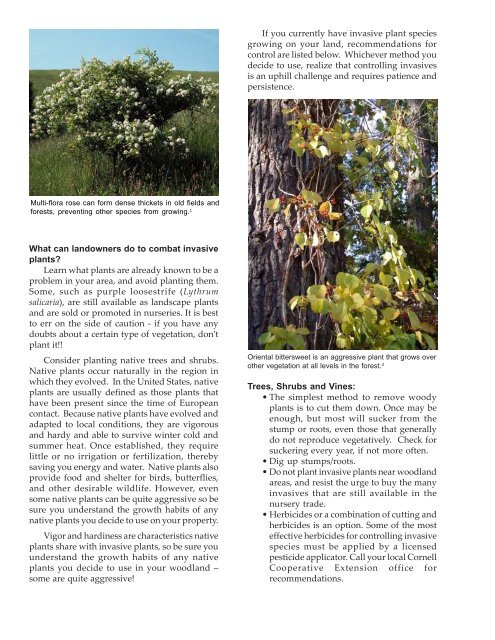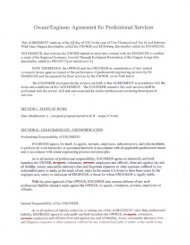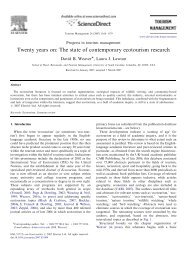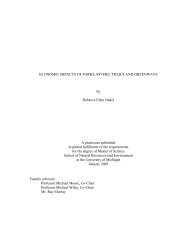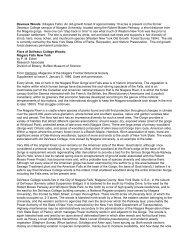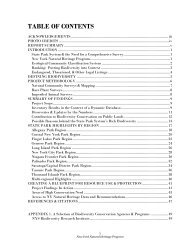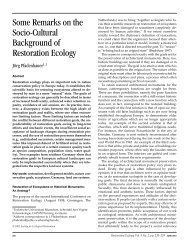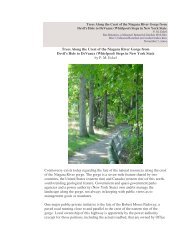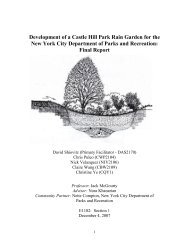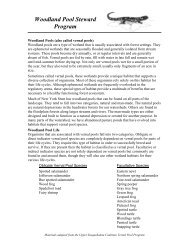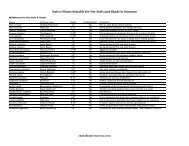Controlling Invasive Species in Woodlots - Wild Ones Niagara
Controlling Invasive Species in Woodlots - Wild Ones Niagara
Controlling Invasive Species in Woodlots - Wild Ones Niagara
You also want an ePaper? Increase the reach of your titles
YUMPU automatically turns print PDFs into web optimized ePapers that Google loves.
If you currently have <strong>in</strong>vasive plant species<br />
grow<strong>in</strong>g on your land, recommendations for<br />
control are listed below. Whichever method you<br />
decide to use, realize that controll<strong>in</strong>g <strong>in</strong>vasives<br />
is an uphill challenge and requires patience and<br />
persistence.<br />
Multi-flora rose can form dense thickets <strong>in</strong> old fields and<br />
forests, prevent<strong>in</strong>g other species from grow<strong>in</strong>g. c<br />
What can landowners do to combat <strong>in</strong>vasive<br />
plants?<br />
Learn what plants are already known to be a<br />
problem <strong>in</strong> your area, and avoid plant<strong>in</strong>g them.<br />
Some, such as purple loosestrife (Lythrum<br />
salicaria), are still available as landscape plants<br />
and are sold or promoted <strong>in</strong> nurseries. It is best<br />
to err on the side of caution - if you have any<br />
doubts about a certa<strong>in</strong> type of vegetation, don’t<br />
plant it!!<br />
Consider plant<strong>in</strong>g native trees and shrubs.<br />
Native plants occur naturally <strong>in</strong> the region <strong>in</strong><br />
which they evolved. In the United States, native<br />
plants are usually def<strong>in</strong>ed as those plants that<br />
have been present s<strong>in</strong>ce the time of European<br />
contact. Because native plants have evolved and<br />
adapted to local conditions, they are vigorous<br />
and hardy and able to survive w<strong>in</strong>ter cold and<br />
summer heat. Once established, they require<br />
little or no irrigation or fertilization, thereby<br />
sav<strong>in</strong>g you energy and water. Native plants also<br />
provide food and shelter for birds, butterflies,<br />
and other desirable wildlife. However, even<br />
some native plants can be quite aggressive so be<br />
sure you understand the growth habits of any<br />
native plants you decide to use on your property.<br />
Vigor and hard<strong>in</strong>ess are characteristics native<br />
plants share with <strong>in</strong>vasive plants, so be sure you<br />
understand the growth habits of any native<br />
plants you decide to use <strong>in</strong> your woodland –<br />
some are quite aggressive!<br />
Oriental bittersweet is an aggressive plant that grows over<br />
other vegetation at all levels <strong>in</strong> the forest. d<br />
Trees, Shrubs and V<strong>in</strong>es:<br />
• The simplest method to remove woody<br />
plants is to cut them down. Once may be<br />
enough, but most will sucker from the<br />
stump or roots, even those that generally<br />
do not reproduce vegetatively. Check for<br />
sucker<strong>in</strong>g every year, if not more often.<br />
• Dig up stumps/roots.<br />
• Do not plant <strong>in</strong>vasive plants near woodland<br />
areas, and resist the urge to buy the many<br />
<strong>in</strong>vasives that are still available <strong>in</strong> the<br />
nursery trade.<br />
• Herbicides or a comb<strong>in</strong>ation of cutt<strong>in</strong>g and<br />
herbicides is an option. Some of the most<br />
effective herbicides for controll<strong>in</strong>g <strong>in</strong>vasive<br />
species must be applied by a licensed<br />
pesticide applicator. Call your local Cornell<br />
Cooperative Extension office for<br />
recommendations.


